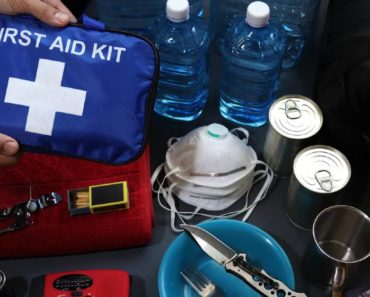The subject of mass food shortages has always been a popular one amongst the prepping community. Regardless of the stated reason for the concern, many a writer has shared their thoughts about what life would be like when the grocery store shelves emptied. Even so, we were all a bit surprised in 2020 when the COVID-19 pandemic hit and the “Great Toilet Paper Shortage of 2020” began. We were even more surprised when that grew into general shortages, and the stores really did empty out.
I have always thought that the pictures people used showing empty store shelves were faked somehow. But now I have a nice collection of pictures of empty store shelves, all of which I can guarantee you are quite real.
But what’s surprised me more than the stores emptying out is that after two years, things still aren’t back to normal. There’s been one thing after another that has kept our supply chain from operating as we are all accustomed to it happening, and to be honest, there doesn’t seem to be any end in sight. If anything, I would say that we can expect the shortages to continue and even get worse.
Before getting into specifics, allow me to say that I would never have thought that one food processing plant going down would really make that much difference. There were a number of food processing plants that shut down during the pandemic, but there was so much going on that it was impossible to see the impact of any one factory. Yet we are now faced with a nationwide shortage of baby formula because of one factory being shut down due to the risk of a bacterial infection.
Granted, that one factory produced about 40% of the baby formula used in this country; but that’s part of the surprise. Even though we’re all used to nationwide brand recognition, I never realized just what that meant from a supply point of view. If the plant producing any one major brand of anything goes down, for whatever reason, it has a wide-reaching impact.
That’s the risk we’re facing right now, and it exists for just about anything you can think of. Many small, local brands are nothing more than national brands that have been packaged for local grocery chains, putting their label on the nationwide brand’s product. So, what we might think of as an alternate source, really isn’t one. That leaves us vulnerable to more shortages.
But just where are these shortages coming from? There are lots of different places, but I’d like to examine just a few.
The War
The most obvious problem that’s currently going on is the Russian invasion of Ukraine. Between the two countries, they account for a large amount of the world’s wheat and fertilizer production, along with a number of other agricultural products. While we don’t use most of those products here, they do affect the world food market. That means that we’re likely to end up providing some food to countries that are affected, which could drive food prices up even more here at home.
There is one thing that we apparently do use from Russia, which could cause some major problems for our agricultural industry; that’s potash for fertilizer. Something like 92% of our agricultural fertilizers depends on Russian supplies. As of right now, the State Department has exempted Russian fertilizer products from the embargo, so we’re okay. But that could all change if Putin decides to “punish us” by cutting off shipments to us.
Fires
Now let me go onto what I think is the most curious of the current problems; that of so many food processing plants catching fire. If you search for this online, you’ll get swamped by articles from “fact-checkers” who are saying that all the conspiracy theories are false. They never seem to deal with the 25 different food processing plants that have caught fire since December. I have the list of them.
According to Snopes (who I normally don’t believe), none of those fires were started as an act of arson. They’re supposedly basing that on reports from investigators on the scene. So, until I hear otherwise, I’m going to give Snopes the benefit of the doubt on this one; but it still smells fishy.
I’m not one to pay much attention to conspiracy theories, but if I was, this just might get me believing in them. While fires in such plants are supposedly not something uncommon, so many of them happening in such a short period of time seems extremely suspicious. I don’t know if these fires are going to continue or not, but the probabilities are stacking up.
One thing that has occurred to me is that if an enemy wanted to do us harm on the cheap, this would be a good way to do so. With our southern border as porous as it is right now, it wouldn’t be hard for a terrorist organization or some country’s intelligence organization to infiltrate a couple dozen operatives into our country. Those facilities can’t be guarded all that well, so starting a fire wouldn’t be any big deal. The only question is whether they could manage to start the fire in such a way that investigators wouldn’t be able to tell what they were doing.
Please note that I’m not proposing that as a conspiracy theory; I’m just stating that the risk exists. With everything else going on and the current state of our supply chain, a rather small group of trained people would have the potential to wreak havoc on our supply lines. As it is, the fries we’re having are probably already having more of an impact than we see.
Cyberattacks
While we’re talking about enemy attacks, we must include cyberattacks. The news media has been keeping quiet about it, but there are constant cyberattacks going on against our farmers and our food processing plants, just like there are against lots of other businesses here in the states.
Remember the ransomware attack against Colonial Pipeline last year? That one gained the hackers 4.4 million dollars. But it wasn’t the only company that had been attacked in that way. There have been a lot more of these attacks than any of us realize, including some against food companies.
Ransomware attacks are a particularly difficult type of cyber attack to protect against. To start with, most companies’ computer networks are old, or at least contain a lot of old components. Even when the company has the latest and greatest for their main computer center, they likely have a lot of outdated equipment feeding information into their main systems, often from automated operations. It’s not physically or financially practical to update those system components every time there’s a new threat, so most companies leave them in place and in the process, leave an attack vector open.
Hackers have become extremely astute in how they use ransomware. Often, it’s installed into the system as a software update. Then it’s allowed to sit there quietly for months. That way, when they trigger the ransomware, the IT department can’t just upload the backups from the day before. It might take them a week to figure out how far back they would have to go in their backups, and that probably won’t help them, as using backups a few months old means losing all the data from the business’ operations in the meantime.
Companies are left with two options: either pay the ransom or shut down operations long enough to replace their systems. That can take a considerable amount of time. Just recently, the factory which produces just about all the cream cheese for the country was hit by a ransomware attack. They couldn’t afford the ransom, so they ended up shutting down. There wasn’t any cream cheese in the stores for over three months.
Imagine what would happen if those hackers managed to hit 100 food-related companies at the same time. That would mean 100 companies that couldn’t produce their products. We’d find alternatives, but that would end up causing second-order shortages, as those other companies couldn’t keep up with demand. The entire supply chain could turn into a train wreck.
Shipping
But there’s something still worse than that going on. That’s the shipping problem. While the backlog of ships off California’s coast is reducing, that was only part of the problem. There’s still a nationwide shortage of truckers, and with the price of gasoline and diesel, that’s not likely to clear up anytime soon.
Over 90% of the trucking companies in the country have six trucks or less, and about 93% have less than 20 trucks. Those small companies can’t afford what’s happening with fuel prices today. With diesel selling for a nationwide average of $5.50 per gallon, it costs between $1,200 and $1,600 to fill the tanks of a truck. With an average fuel mileage of about 6.5 miles per gallon, those 150 gallons of fuel won’t quite take that truck 1,000 miles.
There has been an 18.3% increase in the price of shipping by truck and a 29% increase in maritime shipping since January of last year. That might sound like a big increase, but the cost of diesel has more than doubled in the same amount of time. At that rate, the increase in what trucking companies charge is just barely covering the increase in fuel costs.
It’s hard to say how long that can keep on, especially since the various factors that are causing high fuel prices seem like they’re just going to keep prices rising. If diesel prices rise to the point where truckers can’t afford to keep driving their rigs, we won’t be complaining about how the high cost of shipping is pushing up the cost of food, but we’ll be complaining that there’s no food on the shelves once again.
The thing is, this can happen to us at any time. Realistically, it will probably be a gradual thing, as different truckers decide that they just can’t keep on trucking. But each one that does will make it a bit harder for the system as a whole to keep up with our needs. Eventually, we’ll see the impact in the stores.
What Should We Do?
Between all these risks and the rising price of food, I can see only one option that makes sense – buy whatever you can, whenever you can, stocking up as much as possible. I realize that preppers stock up anyway, but maybe your stockpile is a bit low after the lockdowns and shortages during the pandemic. Well, with the current inflation rate, it sure doesn’t make any sense to just sit on money, watching it lose value; you may as well invest it in food and other necessities.
I’ve long said that food is one of the best possible investments for people who don’t have a lot of money to invest. Food typically outpaces the overall inflation rate, and it’s something we can always use. You don’t have to sell food to make money on it, all you have to do is eat it. That saves you money on buying food, which you can then use for other things.
But there’s more to this idea of buying more food than that. I noticed during the pandemic that many preppers didn’t use their stockpiles to meet their family’s needs, even though that’s what we have those stockpiles for. Rather than use them, though, these people decided to save their stockpile for the next disaster. In other words, they didn’t see the pandemic as enough of a disaster to get into their stockpile, even with the stores running out of food.
So, here’s what I recommend; if your stockpile is down, then go ahead and bring it back up to where it needs to be. But if you’re one of those people who didn’t get into your stockpile, then leave it alone and increase your pantry; if possible, increase it to a month’s worth of food. That way, you’ll have more food to eat if something goes wrong before you have to get into your stockpile.
I’ve already done this, including filling my freezer to the bulging point with meat. While most of us don’t normally stockpile frozen meat, the pandemic has shown me that there are some disasters that can occur, that will still leave us with electricity. So, even though I might lose power, I consider it worthwhile so that I can have a stockpile of meat.
That’s also given me the additional responsibility of making sure that I have a plan of what to do with that meat should the power go out. To start with, I have two generators and a supply of gasoline that’s big enough to last several days. That will keep the freezer going while I preserve that meat. I’ll be using a combination of dehydration and smoking to preserve it, as I have two smokers (one wood and one electric), as well as two dehydrators (one electric and one solar). I’m not sure just how much meat I can process in one day, but I’m pretty sure I can preserve it all before I run out of gas for my generators.





![[VIDEO] Pocket Survival Kit (PSK) – Rescue vs. Self-recovery [VIDEO] Pocket Survival Kit (PSK) – Rescue vs. Self-recovery](https://survivalcove.com/wp-content/uploads/2023/10/CachePSK11-370x297.jpg)


![Survival Medicine Podcast: Hypothermia, Off-Grid Nursing, Pt. 1 [PODCAST] Survival Medicine Podcast: Hypothermia, Off-Grid Nursing, Pt. 1 [PODCAST]](https://survivalcove.com/wp-content/uploads/2021/11/survival-medicine-podcast-banner-370x297.jpg)



















